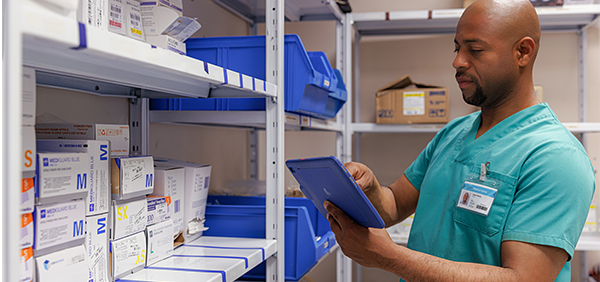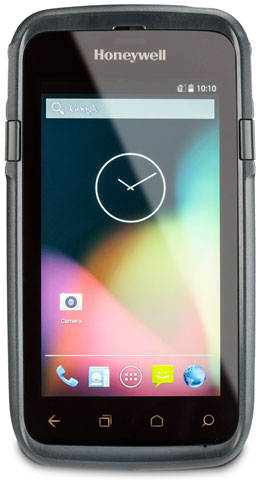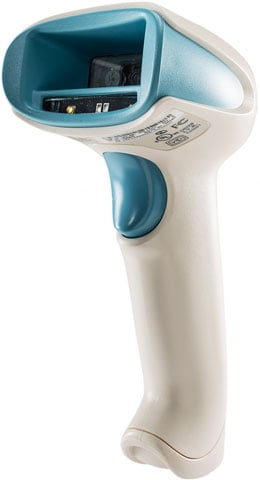How Involving Clinicians in Supply Chain Management Improves Patient Outcomes

In healthcare, it’s no secret that successful patient outcomes depend mainly on the nurses, lab techs and other frontline clinicians at the center of patient interactions. And it’s no mystery that positive results also depend on having the necessary supplies at the place and time they are needed.
What is a mystery, however, is why many hospitals, long-term care facilities, and ambulatory surgery centers fail to involve frontline staff in supply chain management fully. In fact, many healthcare organizations treat inventory management as an administrative task that’s largely separate from hour-to-hour, minute-to-minute clinical operations.
When results depend on what happens on the frontline, doesn’t it make sense to integrate supply chain management right into healthcare workflows?
The answer, of course, is an emphatic “Yes!†and is the topic of a recent healthcare webinar hosted by Barcodes, Inc., with featured guests from Zebra Technologies and Christus Health.
Step One: Involve Frontline Nurses and Clinicians in Inventory Management
When the COVID pandemic hit in March 2020, many healthcare organizations learned how resilient or fragile their supply chains actually were. COVID-related responses tested the entire healthcare system, with workforces strained to — or even beyond — their limits.
It’s safe to say that every healthcare organization dealt with inventory problems during COVID. And it wasn’t just PPD that was affected; just about every critical asset or inventory item was in short supply at one time or another. Organizations with good visibility into inventory on the frontlines had more flexibility to adapt, moving supplies where they most needed them and keeping on top of essential stocks. However, for organizations that did not have supply chain management integrated into frontline operations, every aspect of inventory management was an ongoing struggle, with patients and frontline staff bearing much of the burden.
For many healthcare leaders, this was a lesson in the importance of integrating supply chain management into the routine workflows of every clinician, especially the nurses and lab techs whose effectiveness depends on the availability of supplies.
There are two key takeaways here. First, it is critical to ensure frontline staff has the tools to access and update inventory information as a routine part of their activities without interrupting caregiving. Second, instead of relying on separate and manual inventory processes, inventory data needs to be captured and acted upon automatically in real time because nobody can make time to take inventory when staff is working double or triple shifts.
Step Two: Put Technology to Work
The good news is that the tools needed to integrate inventory processes and supply chain management into routine healthcare workflows are easily attainable. Just about everything necessary to gain real-time inventory visibility can be captured with the mobile devices already being deployed to improve clinician communication and collaboration.
The key is to ensure that mobile devices have data capture capabilities that can be integrated into existing ERP systems. With this capability, every time supplies are moved or used, the action is seamlessly recorded with a handheld mobile computer or tablet in real time.
Integrating inventory data capture links every process to inventory management. Suddenly, nurses and other clinicians become a routine part of supply chain management — without disrupting their usual workflows. The result is that frontline personnel can see what is available, and administrators receive the real-time information they need to make data-driven inventory decisions.
With this simple step, the need for manual inventory processes is significantly reduced, and supply chain management is greatly simplified — even automated. And, because fewer out-of-stock situations mean supplies are available when nurses and other clinicians need them, patients receive better care.
It’s even possible to use the same approach to streamline billing, capturing supplies usage in patient electronic medical records.
Barcodes and Christus Health
Barcodes, Inc. worked closely with Christus Health to deploy a range of Zebra mobile devices throughout their clinical operations. They chose Zebra devices because they’re specifically engineered for healthcare usage, with rugged materials that withstand frequent disinfection, and because they deliver proven barcode scanning tools that make it easy to integrate inventory management into healthcare workflows.
To learn more about how Zebra devices can streamline supply chain management, watch the replay of our webinar or contact your Barcodes, Inc. representative.
How the Healthcare Supply Chain Impacts the Patient Care Experience

Connecting the Dots: The Impact of Healthcare Supply Chain on the Patient Care Experience
Thursday, June 22, 2023
11:00 AM CT
Join us for an insightful webinar led by Zebra’s Chief Nursing Informatics Officer, Rikki Jennings, featuring leaders from CHRISTUS Health, Zebra, and Barcodes Inc.
This panel discussion will explore how an efficient and optimized supply chain can elevate the way patients receive care, ensuring improved outcomes and enhanced satisfaction.
Presented By:
Rikki Jennings, Zebra Technologies, CNIO
John Wirthlin, Zebra Technologies, Industry Principal
Steve Beno, Barcodes, Director of Healthcare Sales
Tim Tassone, Barcodes, Principal Solutions Architect
Featured Speakers:
Susan Pustka, RN, CHRISTUS Health, Director, Infor ERP Services – Technical
Curt Evans, CHRISTUS Health, Director, Infor ERP Services – Supply Chain Management
Key Discussion Points in the Webinar:
Our panel of healthcare supply chain technology experts will address these key topics:
- Importance of supply chain management and its impact on patient care
- Bridging the gap between supply chain and clinical care by involving nursing leadership in the discussion
Watch the Healthcare Supply Chain Technology Webinar
How Clinical Mobility Improves Patient Care
Studies conducted by the Joint Commission have found that nearly 70% of medical errors stem from inefficient communication channels. Facing increasing demands and stress, today’s healthcare providers need -and deserve- dependable technologies that simplify workflows, much like Zebra’s TC52-HC touch computer.
According to Zebra’s 2022 Hospital Vision Study, 72% of facilities reported improved quality in patient care after enhancing clinical mobility. Not only do modernized devices minimize the likelihood of dangerous errors, but they also assist in implementing future-forwards healthcare initiatives without extensive workflow changes.
One mobile device…thousands of possibilities.
Performing several indispensable healthcare tasks such as barcode scanning, push-to-talk, and EHR sharing, the TC52-HC serves as a gateway into several mobility benefits that enhance patient care such as:
- Telehealth – Combine high-speed and long-range WiFi connectivity with the TC52-HC’s high-resolution cameras to reach patients without requiring them to leave their homes and possibly risk their health.
- Faster admissions – Zebra’s MobilityDNA app, SimulScan helps expedite data capture by scanning multiple barcodes at the same time without compromising accuracy. This frees up staff from conducting repetitive clerical work, so they can focus on providing better care.
- HIPPA-compliant data sharing – Unlike other outdated or consumer-grade operating systems, Android for Enterprise helps protect sensitive data with government-grade encryption and recurrent security patches. Moreover, Zebra’s secured text messaging feature enables staff-to-staff communication without risking privacy breaches.
- Efficient and dependable disinfection – Made for constant wipe downs, Zebra’s TC52-HC can be regularly cleaned and disinfected without compromising functionality, minimizing the transmission of HAIs via dirty clinical devices.
To make implementation all the more stress-free, Barcodes, Inc. works closely alongside your IT team and staff to prepare, deploy, and maintain devices with assisted procurement, on-site installation services, and TrueSupport technical support to keep your solution running faster and longer. Contact Barcodes, Inc. today for a free comprehensive evaluation of your facility to start empowering your staff with mobility made for healthcare. Â
How Enhanced Bedside Point-of-Care Combats Hospital Overcrowding
Long before the COVID-19 outbreak, hospital overcrowding has been damaging quality care nationwide, resulting in higher risks of contagion, early staff burnout, and increasing mortality rates. With hospitals reaching bed capacity at alarming speed, the need for faster accurate patient processing has become more crucial than ever. By streamlining admission and discharge procedures, healthcare workers can spend more time providing accurate treatment, shortening the patient’s overall stay and opening up more space for new patients.
To preserve accuracy and patient safety, Barcodes, Inc. partners with Zebra Technologies to enhance bedside point-of-care. From maximized efficiency to increased visibility, see how a streamlined point-of-care solution elevates patient care.
What are the qualities of an enhanced bedside point-of-care solution?
Healthcare officials note three common bottlenecks within hospitals: long admission wait times, complex surgical scheduling, and inefficient discharge[1]. To eliminate these, our technicians simplify real time communication channels with a tailored point-of-care solution, designed with Zebra’s MC55X-HC. The result is:
- Less data entry errors that could lead to medication errors
- Easy access to patient information and profiles when needed
- Secured file sharing and storage
- Faster admission, discharge, and scheduling
To start elevating your point-of-care, contact us for a free
assessment of your current workflow.
[1] Moore, L. Gordon. Hospital overcrowding: A complex but solvable problem. 3M Health Information Systems. May 10, 2019.
Zebra’s New DS8100 Healthcare Series
 Healthcare professionals have a noble but challenging occupation – taking proper care of patients while juggling administrative duties critical to positive patient outcomes. So, when it comes to providing patient care and comfort, settling for anything but the best isn’t an option. That’s why Zebra is introducing the DS8100-HC (Healthcare) Series: a difference-making imager purpose-built to assist healthcare professionals with improving the quality and efficiency of patient care.
Healthcare professionals have a noble but challenging occupation – taking proper care of patients while juggling administrative duties critical to positive patient outcomes. So, when it comes to providing patient care and comfort, settling for anything but the best isn’t an option. That’s why Zebra is introducing the DS8100-HC (Healthcare) Series: a difference-making imager purpose-built to assist healthcare professionals with improving the quality and efficiency of patient care.
The DS8100-HC Series combines performance, adaptability, and manageability so healthcare professionals can perform their data capture tasks accurately and more productively without disturbing their patients. From medication administration to specimen collection, admitting and inventory and dietary management, the DS8100-HC Series is the ideal solution to enhance patient safety, the productivity of staff members and the efficiency of point-of-care operations.
Key Features
- Unparalleled Performance on Virtually Every Barcode in Any Condition
- First-of-its-kind Housing Offers Maximum Protection Against the Spread of Infection
- Flexible User-Selectable Feedback Including Night Mode with Vibrate
- Continuous 24 Hour Scanning
- Exclusive Battery Charge Gauge
- Choice Of Compact USB Powered Cradles
- Doubles as a Workstation Lamp
- FIPS 140-2 Certified
- Apple Certified for iPads and iPhones
- Easy Application Development
1D vs 2D Barcodes Explained
When it comes to tracking anything from basic inventory to patient data, choosing the right type of barcode can be the difference in how effective your system works. Everyone is familiar with the standard picket fence 1D linear barcodes but more and more applications are migrating to 2D barcodes. Both types of codes have their benefits and advantages and our specialists at Barcodes, Inc can help you determine which is the best fit for your needs.
Honeywell’s Dolphin CT50h Keep Clinicians Connected
With the ever changing needs and demands of healthcare providers, clinicians need a device that provides seamless mobile access to clinical systems, vital patient data and connectivity to care teams. Honeywell’s CT50h has been designed to support the most advanced connected mobile user experiences, the latest mobile EMR and nursing applications, and secure care team communication, so workers can more effectively manage a wide variety of tasks throughout their many workflows. Allowing clinicians to be connected while mobile improves the clinical workflow and allows real-time management of alarms or access to patient vitals from anywhere in the hospital.
Honeywell Enhances Hospital Productivity with New Dolphin CT50h
 Honeywell has launched a new clinical mobile device that connects hospital staff to the digital resources they need to provide a safer and more satisfying patient experience.
Honeywell has launched a new clinical mobile device that connects hospital staff to the digital resources they need to provide a safer and more satisfying patient experience.
The new Dolphin CT50h mobile computer incorporates a barcode reader as well as the functionality and user experience of a smartphone to help hospital staff communicate, expedite admissions, simplify specimen collection and provide accurate medication administration.
By automating workflows and communications, Honeywell helps hospital staff become “connected clinicians†– significantly increasing productivity, responsiveness and safety to achieve greater patient satisfaction and enhancing hospital operations.
The Honeywell solution is based on the Dolphin CT50h mobile computer, a powerful AndroidTM device that features best-in-class imaging hardware and decoding software for fast and accurate barcode reading. With a touch-screen interface, the ergonomic handheld computer provides hospital staff with full access to patient data, medical device status, clinical alarm events and secure communications with the care team from anywhere in the hospital.
Night Time Modes: Ensuring Patient Comfort with the Honeywell Xenon 1902h
 Adaptability is a necessity in healthcare. Every clinician has a wide variety of daily tasks and responsibilities to ensure quality patient care. As such, data collection tools need to be just as adaptable as their users. With the Xenon 1902h, such adaptability is not only possible, it is also easy to implement and change to support varied clinician workflows.
Adaptability is a necessity in healthcare. Every clinician has a wide variety of daily tasks and responsibilities to ensure quality patient care. As such, data collection tools need to be just as adaptable as their users. With the Xenon 1902h, such adaptability is not only possible, it is also easy to implement and change to support varied clinician workflows.
A typical standard scanner provides a loud, audible “beep” to indicate a “good read.” While this kind of operator feedback is widely understood, it can be highly disruptive in certain environments; say, during night time operations in an inpatient recovery ward. In these environments, maintaining patient comfort while keeping clinicians productive can be a challenge. That is why our Enhanced Xenon 1902h includes a quick-toggle mode we call Patient Do-Not-Disturb. In this mode, audible feedback is disabled and replaced by additional visual display options that provide positive status indication to the clinician—without disturbing resting patients. Select from multiple silent status indication options, including pulsing of the scanning aimer/imager and/or activation of the back-mounted status LEDs.
Improve Patient Care and Nurse Efficiency with the Zebra MC40-HC
In hospitals and clinics, mobile computers help nurses and lab technicians improve the quality of patient care and save lives by providing instant access to a wealth of business-critical information: real-time lab results, a change in a patient’s condition, or verification of the ‘5 rights’ of medication administration at a patient’s bedside.
Zebra’s MC40-HC is the perfect blend of enterprise functionality in a familiar smartphone form factor that can empower your healthcare staff to improve their daily operations providing more time for patient care.




